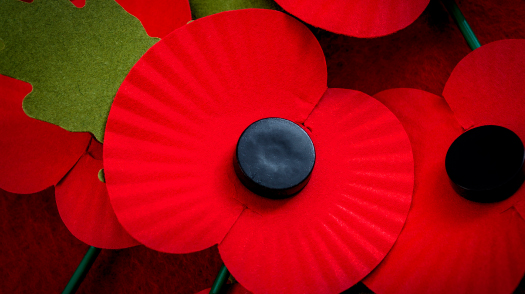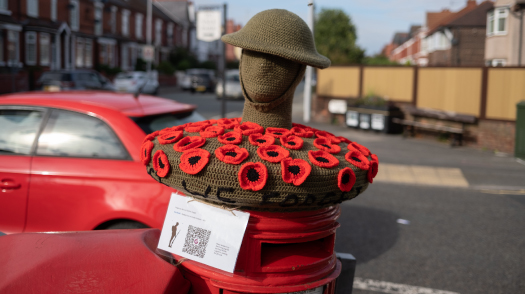Remembrance Day....
Remembrance Sunday in the UK is a day dedicated to honoring the members of the armed forces who lost their lives in the line of duty, particularly during the two World Wars and subsequent conflicts. It's observed on the second Sunday of November each year, which is close to Armistice Day, November 11th, the day World War I ended in 1918. The observance of Remembrance Sunday is a solemn occasion to reflect on the sacrifices made by military personnel and to show respect for those who have served and died in wars.
Here's an overview of the key elements:
The Significance of the Date
Armistice Day (November 11th) marks the end of World War I in 1918, when the armistice was signed between the Allies and Germany. This led to the cessation of hostilities on the Western Front.Remembrance Sunday falls on the Sunday closest to November 11th, so it can vary each year but is always held on the second Sunday of November.

Poppy Appeal
The Poppy is a key symbol of Remembrance in the UK. The Royal British Legion (RBL) runs the Poppy Appeal, a fundraising campaign in the weeks leading up to Remembrance Sunday. People wear paper poppies on their clothes as a symbol of remembrance for fallen soldiers, inspired by the poppies that grew in the fields of Flanders after World War I.Funds raised go toward supporting veterans and their families, providing welfare services, and funding rehabilitation programmes.
The National Service of Remembrance
The most prominent event on Remembrance Sunday is the National Service of Remembrance, which takes place at the Cenotaph (a war memorial) in Whitehall, London. The service is attended by the Royal Family, government officials, veterans, and members of the public.The Cenotaph is a symbol of remembrance and stands as a tribute to those who died in both World Wars and later conflicts.

The Two-Minute Silence
At 11 a.m. on Remembrance Sunday (and also on Armistice Day), there is a two-minute silence observed across the country. It's a time to reflect, pay respects, and remember those who died in wars.The silence begins at 11:00 am, the time when the armistice was signed in 1918.
The Wreath-Laying Ceremony
During the National Service of Remembrance at the Cenotaph, dignitaries, including the monarch, the Prime Minister, and military leaders, participate in a wreath-laying ceremony. They lay wreaths of poppies at the Cenotaph as a sign of respect for the fallen soldiers.Veterans, armed forces personnel, and representatives of other organizations also lay wreaths.
Other Local Ceremonies
While the National Service in London is the focal point, many towns and cities across the UK also hold their own ceremonies at local war memorials. These services often include a minute of silence, the laying of wreaths, and the reading of poems such as "The Fallen" by Laurence Binyon, which includes the famous lines "They shall grow not old, as we that are left grow old: Age shall not weary them, nor the years condemn. At the going down of the sun and in the morning We will remember them."Remembrance in Schools and Communities
In schools, children often participate in activities to learn about the significance of Remembrance Sunday. This might include discussions about the two World Wars, making poppies, or participating in local ceremonies.Local communities often hold smaller services or gatherings, and many people take time to pause and reflect, whether at home or at work.
The Role of the Monarch
The UK monarch (currently King Charles III) plays a prominent role in Remembrance Sunday. They attend the service at the Cenotaph, where they observe the two-minute silence and lay a wreath. This tradition was established by King George V in 1920.The Tone and Atmosphere
The atmosphere of Remembrance Sunday is one of solemnity, respect, and reflection. It's a time for people to pay tribute to the sacrifices made by service members, not just during the World Wars but in all conflicts since.The use of military music, the marching of veterans, and the ceremonial aspect all contribute to a very dignified and reflective mood.
Remembrance Sunday vs. Armistice Day
Armistice Day (November 11th) marks the specific moment when the First World War ended, and it's observed with a brief two-minute silence at 11 a.m. But Remembrance Sunday, which is on the Sunday closest to Armistice Day, is the main national day of remembrance for all wars and conflicts.While Armistice Day is more focused on the historical end of World War I, Remembrance Sunday includes a broader focus on all those who have died in military service.

Additional Observances:
Many Commonwealth countries, including Canada, Australia, and New Zealand, also observe Remembrance Day, often with similar ceremonies. In some countries, it's called Veterans Day (in the U.S.) or Anzac Day (in Australia and New Zealand), though the focus of the observance can differ.Remembrance Sunday holds deep cultural and national significance in the UK, serving as both a memorial to the past and a reminder of the sacrifices made by those who served their country. It's an event that transcends political, social, and regional boundaries, uniting the UK in collective memory.
